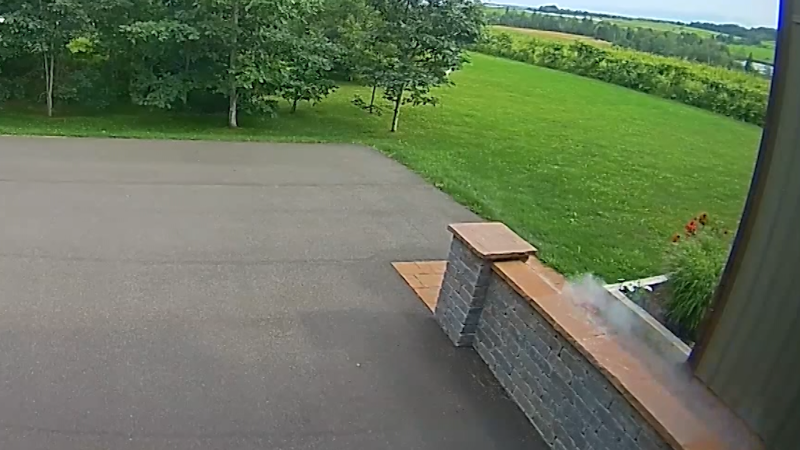On a typical sunny afternoon in July 2024, a seemingly ordinary event unfolded on Prince Edward Island, Canada, that would soon turn extraordinary. Joe Velaidum and his partner, Laura Kelly, were out taking a walk with their dog. As they prepared to leave, Velaidum noticed an abandoned dog leash in their yard, prompting him to pause momentarily and pick it up. This split-second decision would later become a pivotal moment in their lives.
Minutes after Velaidum resumed their walk, an unexpected event occurred: a meteorite crashed onto their property. The incident was captured on a Ring doorbell camera at their home, marking a remarkable stroke of luck. Velaidum recounted to CNN how he typically avoids that specific spot in his yard, affirming that had he lingered there even for two minutes longer, he might have suffered a severe injury or even death from the sudden meteorite strike.
In the weeks that followed, scientific investigations confirmed the object was, indeed, a meteor — a classified specimen later cataloged by the Meteoritical Society under the name “Charlottetown,” after the nearby city. This meteorite’s story is unique not just because of its impact; it is one of the few instances caught on video, showing close proximity and sound, as noted by Dr. Chris Herd, a professor at the University of Alberta, who also oversees the university’s meteorite collection.
Herd acknowledged the meteorite’s dramatic entrance, stating, “The Charlottetown Meteorite sure announced its arrival in a spectacular way.” The footage of its landing is significant, as it provides researchers with a rare opportunity to analyze both the speed of the meteorite as well as the sound, contributing to scientific understanding of such celestial phenomena. Even in Herd’s extensive career as a meteorite researcher, he emphasized that collection events like this in Canada are incredibly rare.
The University of Alberta processes about ten meteorite reports weekly, with fewer than one percent proving to be genuine. Initially skeptical, Velaidum thought the object might originate from an aircraft or even be debris from his own roof. Together with Kelly, they began cleaning up the scattered remnants of the impact. However, it was a nudge from Kelly’s father that encouraged them to collect some samples for further analysis.
Using tools like a vacuum and a magnet, the couple managed to gather a 95-gram piece of the meteorite which they later sent to the University of Alberta along with some photographs. Herd, upon seeing the samples, immediately recognized them as authentic space rock. The uniqueness of this meteorite strike is compounded by the realization that it is the first confirmed strike in the recorded history of 2,200 square miles of Prince Edward Island.
Notably, coincidences surrounding the incident abound. Thanks to the timing of the event, Velaidum narrowly escaped injury, and Dr. Herd had already scheduled a family vacation to the island shortly after, allowing him to retrieve the meteorite in person. Velaidum, who teaches a religious studies course that discusses existential themes and the vast universe, described how the meteorite incident provides compelling material for examining life’s absurdities and coincidences within a cosmological context.
In terms of the meteorite’s classification, it is categorized as an “ordinary chondrite,” which, despite its common labeling, has a fascinating provenance. Experts believe such meteorites likely originate from fragments that broke away from asteroids located between Mars and Jupiter in the asteroid belt. According to Herd, this particular piece was likely floating through space for millions of years before its unexpected entry into Earth’s atmosphere.
Today, the Charlottetown meteorite is housed alongside over 1,800 specimens at the University of Alberta’s Meteorite Collection, which holds the distinction of being the largest repository of its kind in Canada. Herd pointed out that while many individuals may suspect they have found a meteorite, earthly substances often masquerade as space rocks. Differentiating between true meteorites and what the scientific community humorously refers to as “meteorwrongs” is crucial, as these studies yield essential insights into our universe’s origins and history.
In conclusion, the tale of the Charlottetown meteorite serves as a reminder of the interplay between fate, science, and human curiosity. In a fleeting moment that could have had tragic consequences, Velaidum and Kelly transitioned from ordinary pet owners to amateur meteorite discoverers, ultimately enriching our understanding of the cosmos while underscoring the wonder that exists just beyond our planet.











